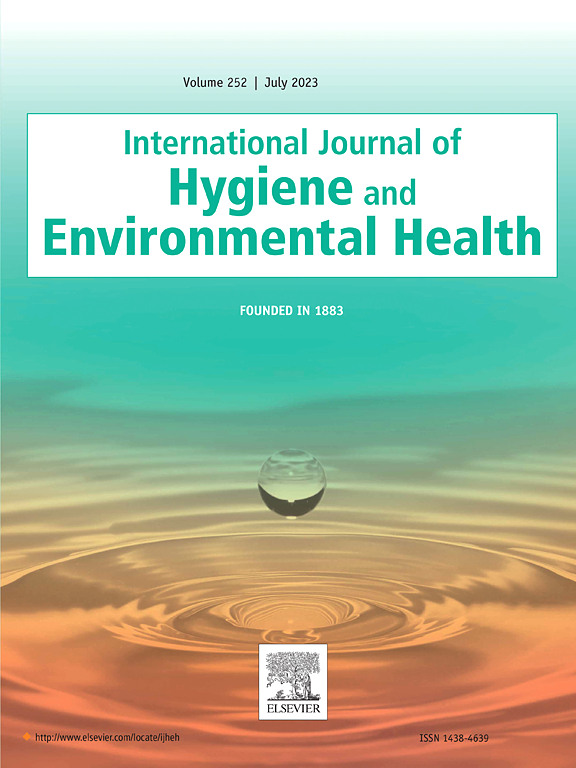Enhancing data interoperability in human biomonitoring studies: the HBM data toolkit
IF 4.4
2区 医学
Q1 INFECTIOUS DISEASES
International journal of hygiene and environmental health
Pub Date : 2025-09-01
DOI:10.1016/j.ijheh.2025.114669
引用次数: 0
Abstract
Harmonization and aggregation of heterogeneous data from Human Biomonitoring (HBM) studies is critical to enhance the reliability of conclusions and move towards FAIR (i.e., Findable, Accessible, Interoperable, Reusable) data. We introduce the HBM Data Toolkit developed by the Flemish Institute for Technological Research (Vlaamse Instelling voor Technologisch Onderzoek - VITO) with the primary goal of optimizing data integrity and interoperability, key steps towards FAIR, while using flexible templates and ensuring data confidentiality. The HBM Data Toolkit was built in 2023–2024 and made available for stakeholders (via https://hbm.vito.be/tools) within the Partnership for the Assessment of Risks from Chemicals (PARC eu-parc.eu). The toolkit consists of 4 modules including data harmonization, data validation, derived variables, and summary statistics calculation. A Python package was created to interpret the templates, making validation and transformation possible. Using Pyodide and WebAssembly, the toolkit runs entirely in the web browser, enabling secure, local execution of Python code without uploading any data. In the validation module, input files in common format (i.e., Excel) were used to configure data templates, aligning with standards and formats as specified under the HBM4EU project (hbm4eu.eu) and PARC. The HBM Data Toolkit allows harmonized data storage in the Personal Exposure and Health (PEH) data platform. Formatted and validated HBM data were made compatible with the Monte Carlo Risk Assessment (MCRA) platform. In the derived variables calculation module, the toolkit also allows users to calculate imputed censored data and standardize/normalize the biomarker data. Furthermore, summary statistics (e.g., geometric mean, percentiles) can be calculated and further visualized in the European HBM dashboard and integrated into the Information Platform for Chemical Monitoring (IPCHEM). In conclusion, the current toolkit proves effective in advancing data quality, harmonization, and aggregation in HBM studies. With local execution, user-friendly codebooks, and standardized schemas, it supports a unified framework that enables consistent analysis and interpretation across diverse studies and datasets.
加强人类生物监测研究中的数据互操作性:HBM数据工具包
人类生物监测(HBM)研究中异构数据的协调和聚合对于提高结论的可靠性和向FAIR(即可查找、可访问、可互操作、可重复使用)数据迈进至关重要。我们介绍了由弗拉芒技术研究所(Vlaamse Instelling voor technology Onderzoek - VITO)开发的HBM数据工具包,其主要目标是优化数据完整性和互操作性,这是实现公平的关键步骤,同时使用灵活的模板并确保数据机密性。HBM数据工具包于2023-2024年建立,并在化学品风险评估伙伴关系(PARC eu-parc.eu)内提供给利益相关者(通过https://hbm.vito.be/tools)。该工具包由4个模块组成,包括数据协调、数据验证、派生变量和汇总统计计算。创建了一个Python包来解释模板,使验证和转换成为可能。使用pyoide和WebAssembly,该工具包完全在web浏览器中运行,无需上传任何数据即可安全本地执行Python代码。在验证模块中,使用通用格式(即Excel)的输入文件来配置数据模板,并与HBM4EU项目(HBM4EU .eu)和PARC规定的标准和格式保持一致。HBM数据工具包允许在个人暴露和健康(PEH)数据平台中统一存储数据。格式化和验证的HBM数据与蒙特卡洛风险评估(MCRA)平台兼容。在衍生变量计算模块中,该工具包还允许用户计算输入的审查数据并标准化/规范化生物标志物数据。此外,汇总统计数据(如几何平均值、百分位数)可以在欧洲HBM仪表板中计算和进一步可视化,并集成到化学品监测信息平台(IPCHEM)中。总之,目前的工具包在提高HBM研究中的数据质量、协调和聚合方面被证明是有效的。通过本地执行、用户友好的代码本和标准化的模式,它支持一个统一的框架,可以跨不同的研究和数据集进行一致的分析和解释。
本文章由计算机程序翻译,如有差异,请以英文原文为准。
求助全文
约1分钟内获得全文
求助全文
来源期刊
CiteScore
11.50
自引率
5.00%
发文量
151
审稿时长
22 days
期刊介绍:
The International Journal of Hygiene and Environmental Health serves as a multidisciplinary forum for original reports on exposure assessment and the reactions to and consequences of human exposure to the biological, chemical, and physical environment. Research reports, short communications, reviews, scientific comments, technical notes, and editorials will be peer-reviewed before acceptance for publication. Priority will be given to articles on epidemiological aspects of environmental toxicology, health risk assessments, susceptible (sub) populations, sanitation and clean water, human biomonitoring, environmental medicine, and public health aspects of exposure-related outcomes.

 求助内容:
求助内容: 应助结果提醒方式:
应助结果提醒方式:


